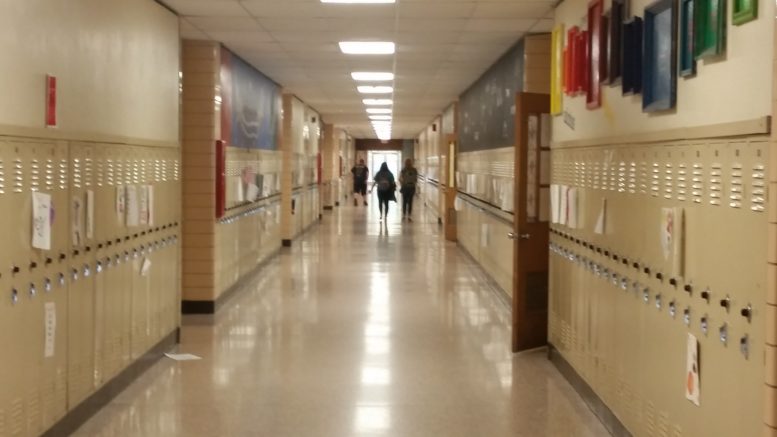By JAN LARSON McLAUGHLIN
BG Independent News
Another flyer has been delivered to Bowling Green City School District voters, trying to convince them to vote against the school building tax issue on the Nov. 7 ballot.
This mailer, sent out by a newly-minted group called Wood County Citizens Against Higher Property Tax, criticizes the size of the 6-mill school levy, the plans for consolidation and the management of district funds.
One week before the election, Bowling Green Superintendent Francis Scruci is again defending the levy as necessary for the district.
“From day one, we’ve tried to give out as much factual information as we can,” he said.
For the second time, the district has been targeted by flyers warning people about the levy. The problem, Scruci said, is that both have been riddled with misinformation. The first mailer, sent out by a Bowling Green businessman, included incorrect tax numbers.
This second one, which showed up in mailboxes on Monday, has “blatant disregard for the numbers,” Scruci said.
The flyer warns of decreased business growth due to taxes, and increased crime in the schools due to consolidation.
“We’ve stuck to the facts from day one,” Scruci said. “This is discouraging. For the second time we are dealing with a group of people trying to scare our taxpayers.”
The flyer includes charts comparing local district school funding to state school funding. “As you can see the good property owners of Bowling Green pay more than their fair share to support this school system,” the mailer states.
The problem is, Scruci pointed out, that the pie chart does not show the state average as the flyer claims. Instead, it shows the state total.
“They are comparing the district collection to the total of the state – not the average,” the superintendent said.
When asked about the pie charts, Grant Chamberlain, a member of the Wood County Citizens Against Higher Property Tax, defended the information. When it was pointed out that the second chart is the state total, not the state average, Chamberlain said if it were a state total, it would be in billions, not millions. When advised that the number is billions, the phone line went dead.
The flyer also claims that by consolidating the elementaries, the district will encounter more safety issues. Small schools with fewer than 300 students, compared to big schools of 1,000 or more students, have much higher crime rates. The flyer warned there would be 1,000 percent more weapon incidents and 3,200 percent more robberies.
Scruci said those numbers just aren’t true. Besides, he said, there is no school building in the district now with fewer than 300 students. Crim Elementary has 595, and Conneaut and Kenwood have about 450 each.
The mailer questions the district’s consolidation plans, calling it a “failed” trend. Smaller schools, according to the flyer, “engage a broader cross-section of students, helping to reduce social and racial isolation. This increases achievement and investment by the students.”
However, Scruci said consolidation of the elementaries will create equity of resources, opportunities and class sizes, will eliminate labels associated with each elementary building, and will allow for daily teacher collaboration by grade level which will improve instruction and learning.
The flyer also warns that the $72 million bond issue over 37 years is too much and too long. This year’s kindergarten class will be 42 years old before the tax expires.
Scruci, who has made nearly 100 public presentations on the levy, has never disputed that the levy is asking a lot of voters.
“It is a lot of money. It is 37 years,” he said. “But the longer you wait, the more expensive things become.”
And as far as taxpayers footing the bill for schools – “somebody paid for my education when I was in school,” Scruci said.
Every other school district in Wood County has new school buildings. Bowling Green’s elementaries were built in the 1960s and cannot keep up with the demands of today’s learners, he said.
“We were trying to balance the needs with what we thought our residents could handle,” Scruci said. For the owner of a $100,000 home, the levy will cost $210 a year. If the bond issue was shortened to 20 years, that same homeowner would have to pay $303 a year – so the district went with the longer bond.
The Wood County Auditor’s Office has calculated the average annual cost per acre of farmland in the Current Agricultural Use Value program at $6.53.
“From day one, we’ve said we understand this is a lot of money,” Scruci said.
The flyer warns that passage of the levy would cause rental rates within the district to increase, force fixed income and low income households to make tough decisions, and force farmers to dig into their “already dismal crop margins” to pay more for schools. It also states that business investments will leave Bowling Green.
That last point about businesses moving has been disputed by local economic development officials, who have said that prospective businesses and families interested in Bowling Green often decide to go elsewhere when they see the city schools. Bowling Green is the only district in the county to not have new buildings. And Bowling Green’s tax millage is actually seventh highest out of 15 school districts with property in the county.
Prior to hanging up, Chamberlain said the economic development officials were not presenting accurate information.
“I’m just trying to present the facts,” he said. The district won’t listen to “any scholarly evidence that’s contrary to their sales pitch.”
The flyer is also critical of the district’s “out of control spending,” and states that no lasting significant changes have been proposed to curb spending.
In response to that, Scruci rattled off the cuts already made or proposed with the new building plans: $100,000 a year by reducing shuttle bus routes; $60,000 a year for leasing administration building; $20,000 a year for ending use of modular units at Conneaut; $100,000 a year for ending busing to some private schools; plus huge utility savings. The district would also have the ability to increase revenue by offering more programs for children with special needs and an expanded preschool program.
“We’re always looking at ways to cut spending,” Scruci said.




